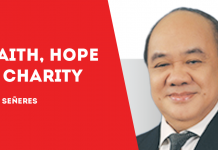
FORMER Technology Resource Center (TRC) director general Ms. Chitang Nakpil has defined “technology” in a way that everybody could easily understand. She said “technology is a better way of doing things”.
Mr. Ito Carlos of the Philippine Foundation for Science and Technology (PFST) defines “technology” by way of comparison, saying that “technology is the application of science”.
In a manner of speaking, the definitions of Ms. Nakpil and Mr. Carlos actually compliments each other, if we could all agree that “technology is the application of science, to do things in a better way”.
It is a long story how I ended up in the science and technology (S&T) advocacy. I became familiar with TRC way back in my days with the Ministry of Human Settlements (MHS), when I was a Group Product Manager and Assistant Vice President of Bliss Marketing Corporation (BLISSMARK) which was also a subsidiary of the Human Settlements Development Corporation (HSDC), in the same way that TRC was also an HSDC subsidiary at that time. As a matter of fact, BLISSMARK and TRC were next door neighbors in our Makati offices.
After my stint with MHS, I became a Senior Partner of Technology Ventures, Inc. (TVI), a company founded by Mr. Arthur Alvendia who was also a former Director General of TRC, just like Ms. Nakpil. It was in TVI that I learned hands on how to apply science in the form of technology, in the manner that Mr. Carlos has described.
Looking back, Mr. Alvendia showed me how to turn technologies into businesses, how to bring technology based products into the mass markets.
During my stint with the Philippine Consulate General in New York City, I became an officer of the Science and Technology Advisory Council (STAC), an organization of expatriate Filipino scientists and technologists that was attached to the Department of Foreign Affairs (DFA). STAC was also closely associated with the Brain Gain Network (BGN), an association of Filipino students in America who were working for the transfer of foreign technologies to the Philippines.
Upon my return to the DFA Home Office in Manila, I was assigned as Director of the Science & Technology Unit (STU) under the Office for Economic Cooperation (OEC) headed by DFA Undersecretary Federico M. Macaranas. In that capacity, I also supervised several offices that were under Dr. Macaranas, namely STAC, BGN, Technological Information Promotion System (TIPS), Return of Knowledge and Technology (RKT) and the Transfer of Knowledge thru Expatriate Nationals (TOKTEN).
Also in that capacity, I was designated as the DFA representative to the Science & Technology Coordinating Council (STCC), the National Information Technology Council (NITC) and the Steering Committee for the Balik-Scientist Program in coordination with the Department of Science & Technology (DOST). Sad to say, both STCC and NITC are now defunct. STCC is as good as dead, but some functions of NITC have been absorbed by the existing Information & Communications Technology Office (ICTO), and agency under DOST.
During those days, the popular notion was that ICT was a derivative of S&T, a legal fiction that should still be accepted up to now. That is consistent with the view of Mr. Carlos that “technology is the application of science”. This is perhaps the logic behind the decision of the government to place ICTO under the DOST. On a broader scale however, we are still facing the bigger challenge of how to make use of science so that it could already be applied or deployed in the form of technology, and I do not mean ICT only.
I thought I knew everything about TRC, until I heard from Mr. Dennis Cunanan, the incumbent TRC Director General that it is supposed to be the repository of S&T for the good of the people. On a higher scale, it is supposed to be the repository of all S&T for the long term survival of our nation. In this sense, it is good to know that TRC is now under DOST. Looking back however, I think it was a bad decision to inject the livelihood function into TRC before, because it actually marginalized its noble role as the repository of S&T.
I also found out that under its charter, TRC is tasked with the official role of bringing out inventions to market. Until now, I did not know that another government agency has this function. I thought that the Technology Application and Promotion Institute (TAPI) under the DOST was the only agency that was tasked with this function.
I do not mind the fact that there would be a duplication of functions if these two agencies would work together, because what is important is to bring out Filipino inventions to market. As a matter of fact, that should not be a problem at all, because TRC and TAPI are both under DOST.
I think that it would be a good idea to revive both STCC and NITC, but this time under one council, following the legal fiction that ICT is actually a derivative of S&T. This time however, I think that the jointly revived council should be led by the private sector, in the spirit of Public and Private Cooperation (PPP). Since the idea is to bring out Filipino inventions to market, it should have the active participation of the DOST and the Department of Trade & Industry (DTI).
Bringing out Filipino inventions to market is just one way, the outbound way. Bringing in foreign technologies is the other way, the inbound way. The problem now is that there is a technology gap in the inbound way, because it takes many years before foreign technologies are applied or deployed locally.
Something has to be done in order to shorten this technology gap, so that in would only take months, and not years. One way or the other, the government should make it easy for foreign technologies to be quickly applied or deployed locally./PN

